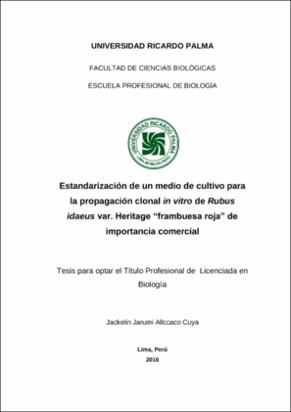“Estandarización de un medio de cultivo para la propagación clonal in vitro de Rubus idaeus var. Heritage “frambuesa roja” de importancia comercial.“
Resumen
La presente investigación se realizó con el objetivo de estandarizar un medio de cultivo para la propagación clonal in vitro de Rubus idaeus L. variedad Heritage “frambuesa roja”, para lo cual se desarrollaron ensayos de establecimiento, multiplicación, enraizamiento in vitro y aclimatación. Las plantas madre de frambuesa se obtuvieron del vivero Los Inkas (Lima) y fueron mantenidas en condiciones de invernadero en la Universidad Ricardo Palma. Se tomaron miniestacas de 2 - 3 cm, se esterilizaron en condiciones asépticas y se sembraron ápices meristemáticos y miniestacas en medio Murashigue and Skoog (MS) a 1/4, 1/2, 3/4 y concentración completa de sales. Las plántulas obtenidas fueron multiplicadas en medio de cultivo con 1, 1.5, 3 mg/L de 6-bencilaminopurina (6-BAP), y en combinación con 0.5 y 1 mg/L de ácido giberélico (GA3). Estas fueron enraizadas en medio con 0.5, 1, 2 mg/L de ácido indol acético (AIA) y 1mg/L de AIA con 0.5 mg/L de carbón activado. Las plántulas enraizadas fueron transferidas a cámaras de aclimatación en sustrato turba:arena:humus (1:1:0, 2:1:0 y 1:1:1 v/v). Los resultados muestran el desarrollo de brotes en un 80% a partir de miniestacas cultivadas en medio MS con sales completas con altura promedio de 1.088 cm. El medio de multiplicación suplementado con 1 mg/L de 6-BAP y 0.5 mg/L de GA3, permitió obtener 5.4 brotes / miniestaca. Asimismo, se logró obtener 70% de plántulas enraizadas en medio a mitad de concentración de sales suplementado con 1 mg/L de AIA y 100% de sobrevivencia de plántulas aclimatadas en sustrato turba:arena (1:1 y 2:1 v/v) utilizando cámaras de aclimatación.
This research was conducted with the purpose to standardize a culture medium for in vitro clonal propagation of Rubus idaeus L. variety Heritage "red raspberry", for which assays of in vitro establishment, multiplication, rooting and acclimatization were developed. Raspberry mother plants were obtained from the plant nursery Los Inkas (Lima) and were kept in the greenhouse at the University Ricardo Palma. Nodal segments of 2 - 3 cm were taken, sterilized under aseptic conditions and shoot tips and nodal segments were cultured in 1/4, 1/2, 3/4 and full strength Murashigue and Skoog (MS) medium. Plantlets were multiplied in culture medium with 1, 1.5, 3 mg/L of 6-benzylaminopurine (6-BAP), and in combination with 0.5 and 1 mg/L of gibberellic acid (GA3). These were rooted in medium with 0.5, 1, 2 mg/L of indole acetic acid (IAA) and 1 mg/L of IAA with 0.5 mg/L of activated charcoal. Rooted plantlets were transferred to acclimatization chambers in substrate peat:sand:humus ( 1:1:0, 2:1:0 and 1:1:1 v/v). The results show the development of shoots by 80% from nodal segments cultured in full strength MS medium with average height of 1.088 cm. The multiplication medium supplemented with 1 mg/L of 6-BAP and 0.5 mg/L GA3, alloed the growth of 5.4 shoots/explant. Also, 70% of rooted plantlets were obtained in half strength MS medium supplemented with 1 mg/L of IAA, and 100% of survival of acclimatized plantlets in peat:sand (1:1 and 2:1 v/v) using acclimatization chambers.
Colecciones
- Biología [176]


